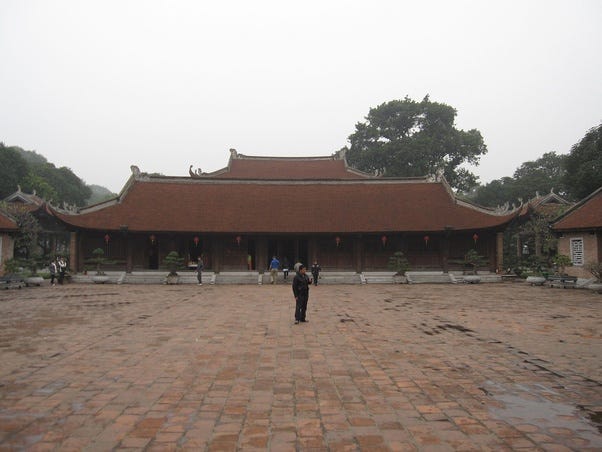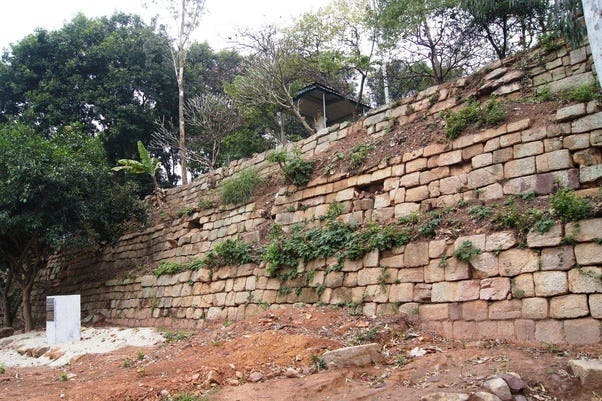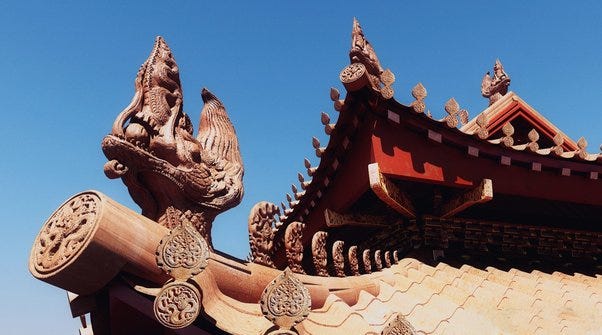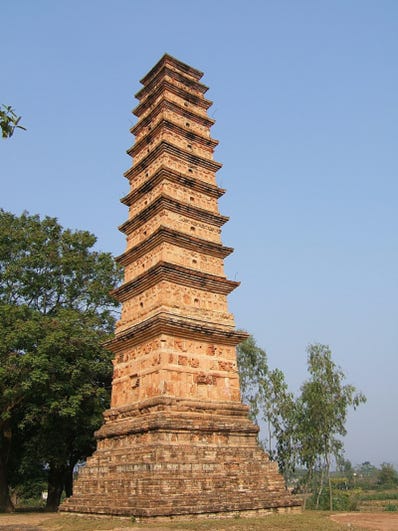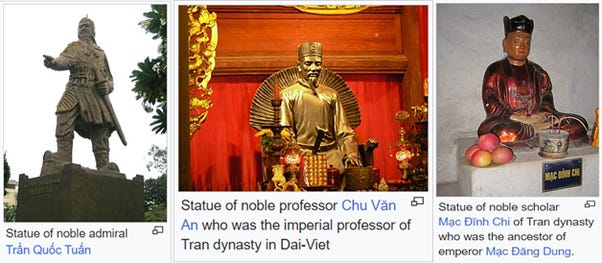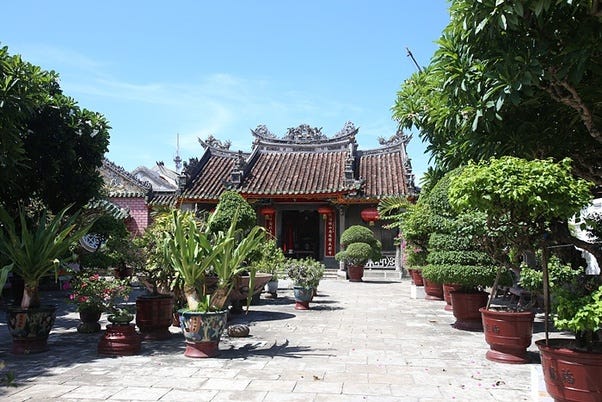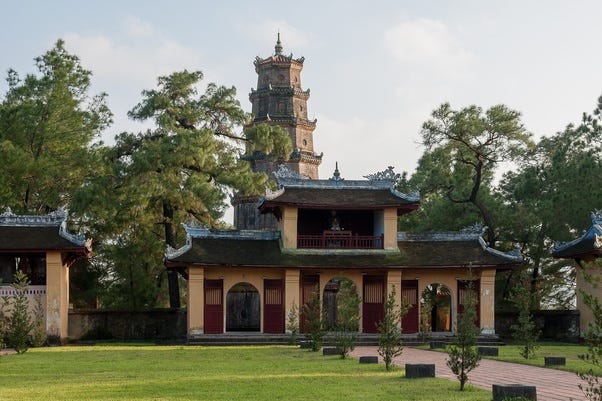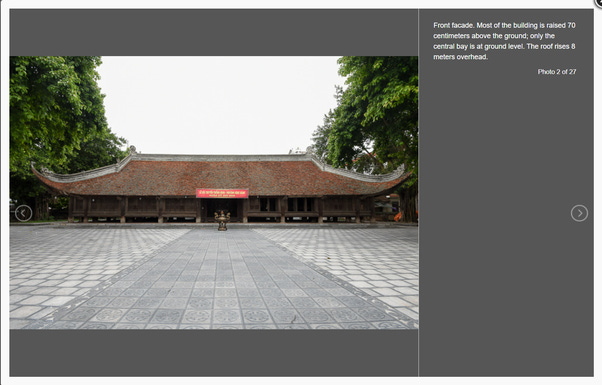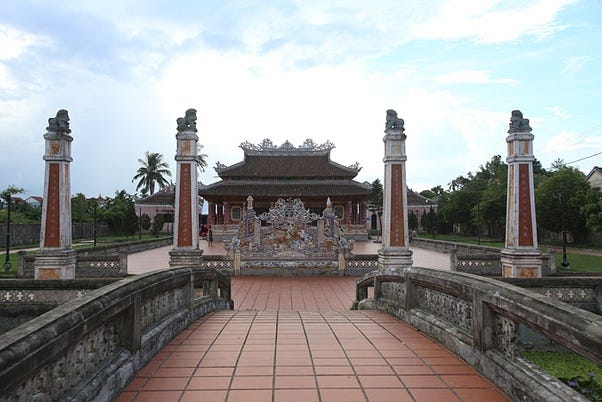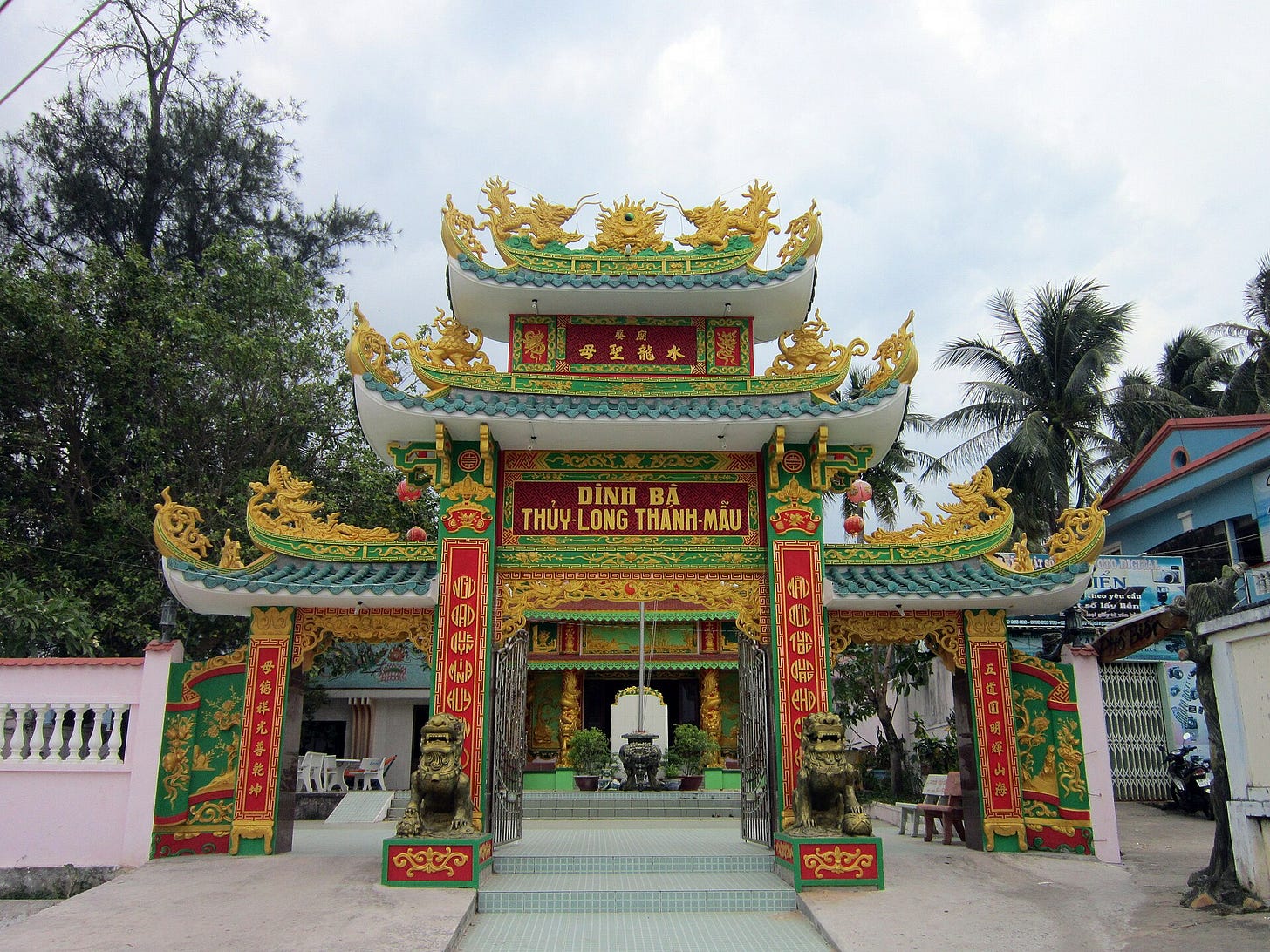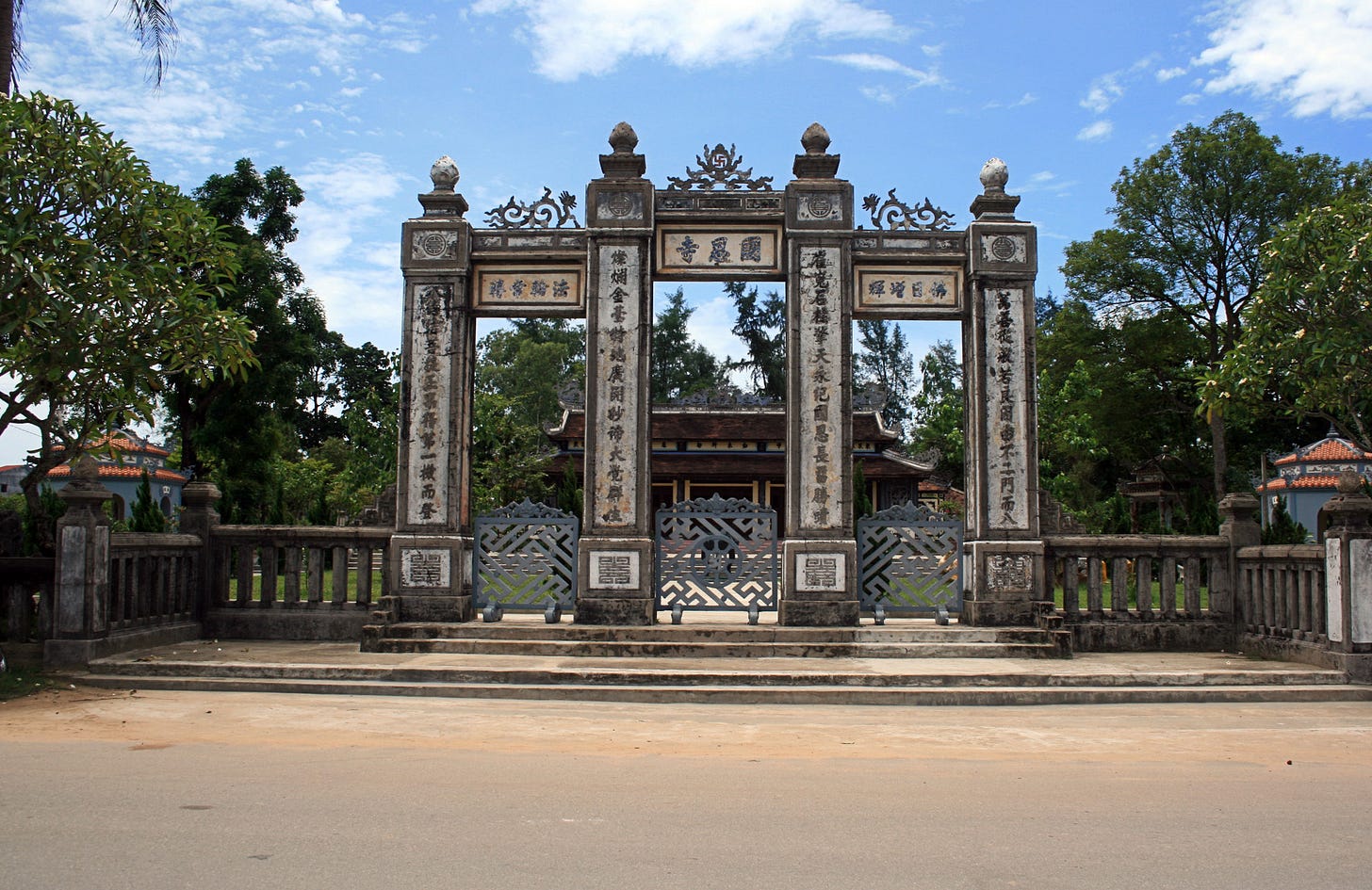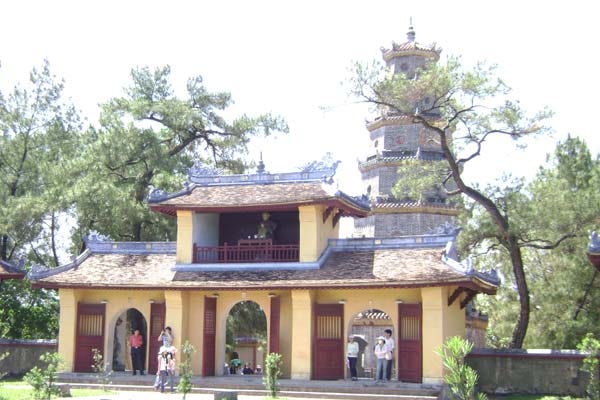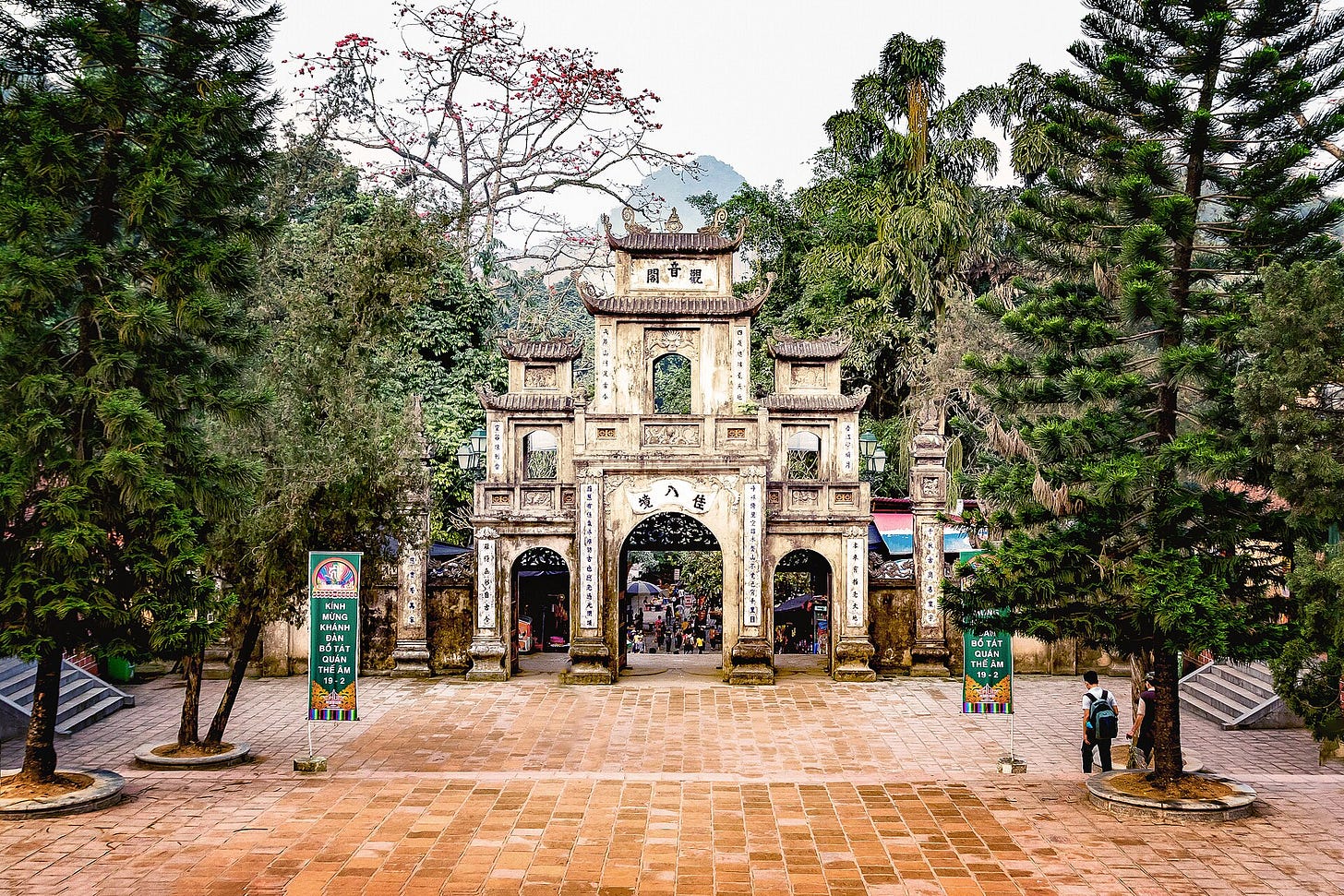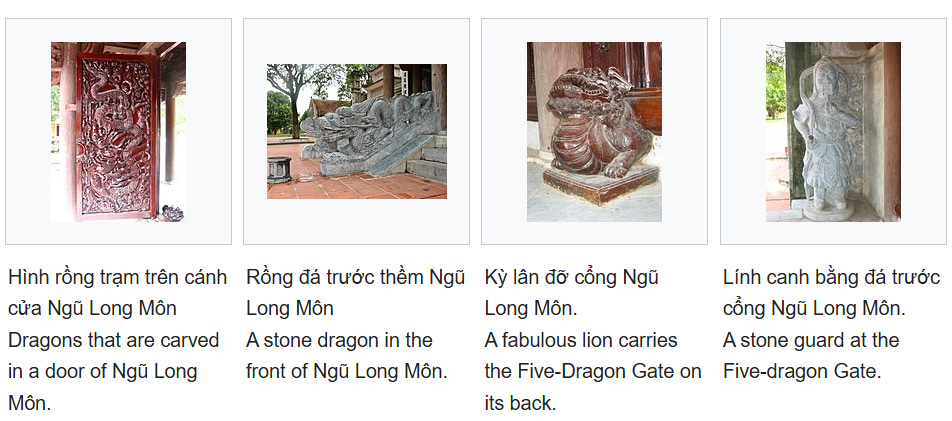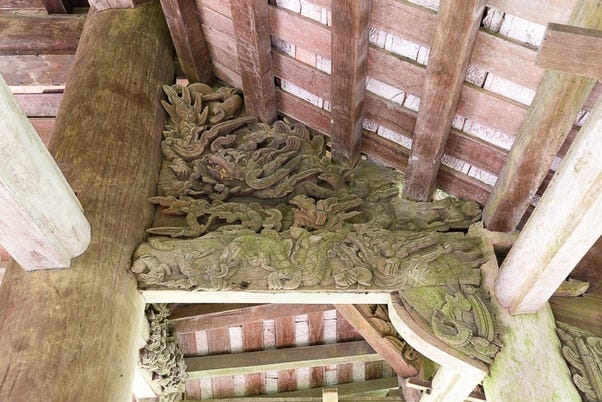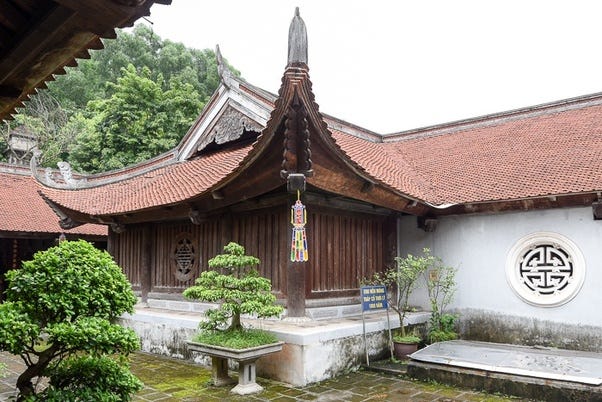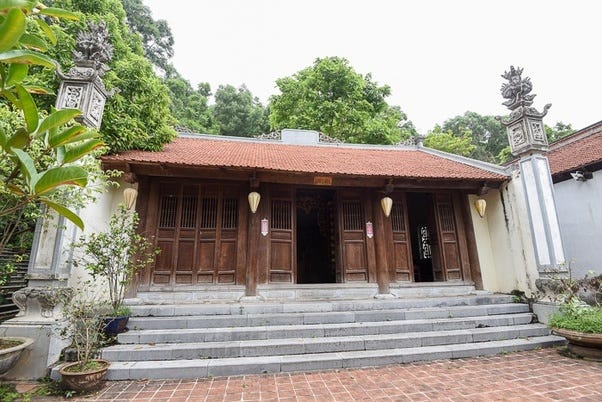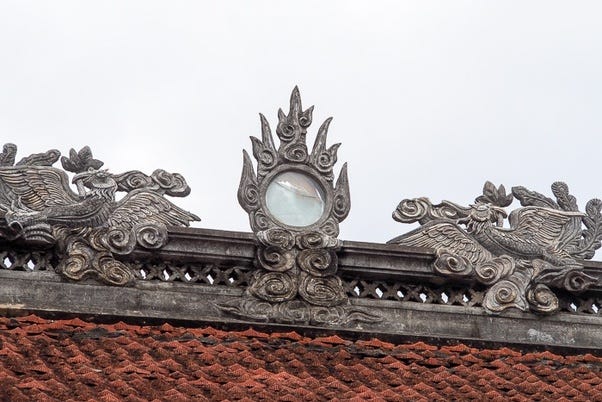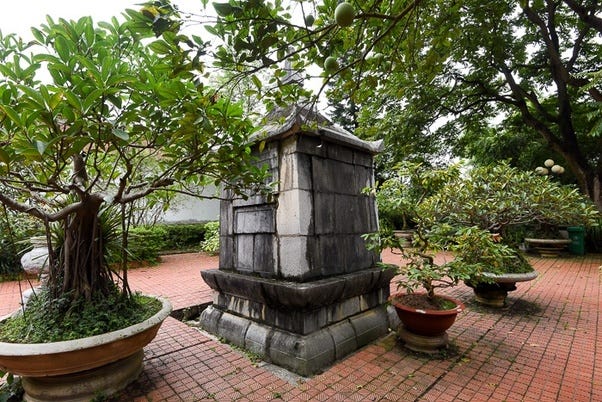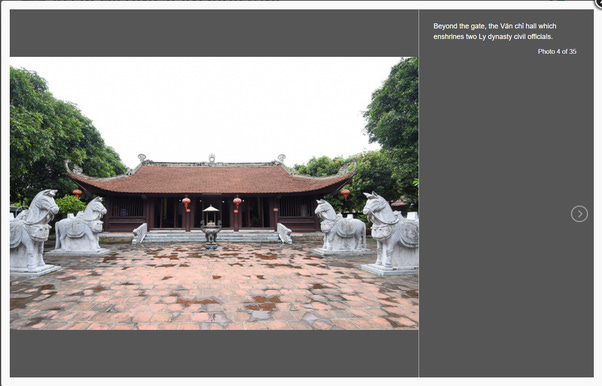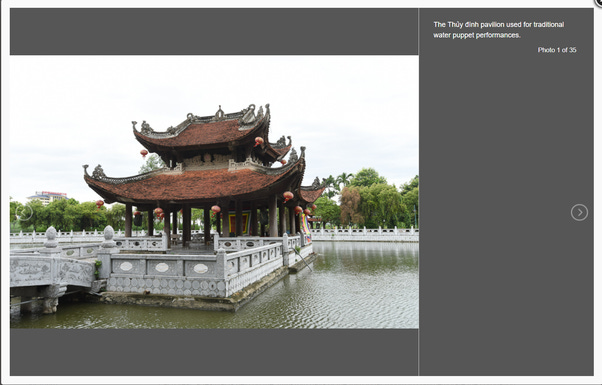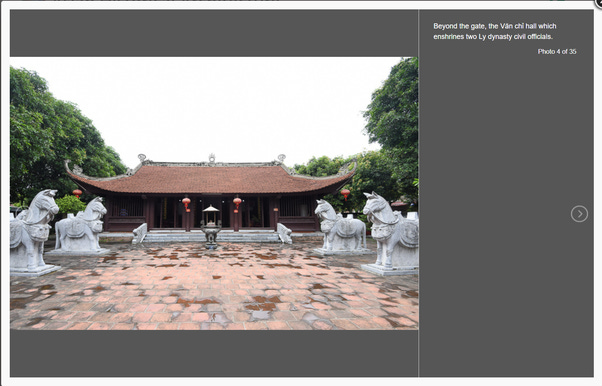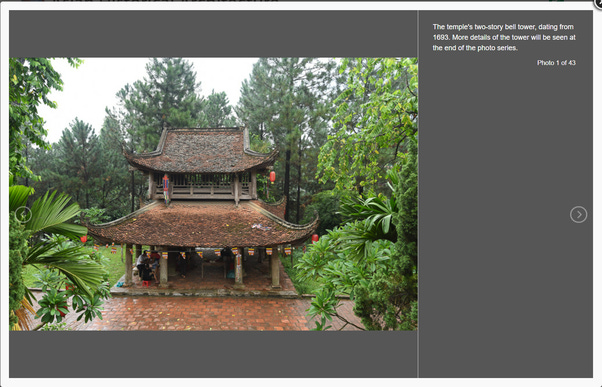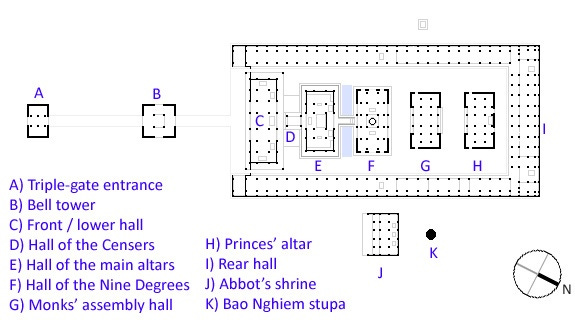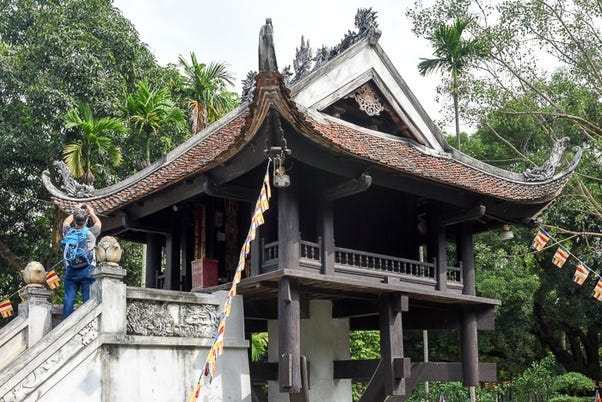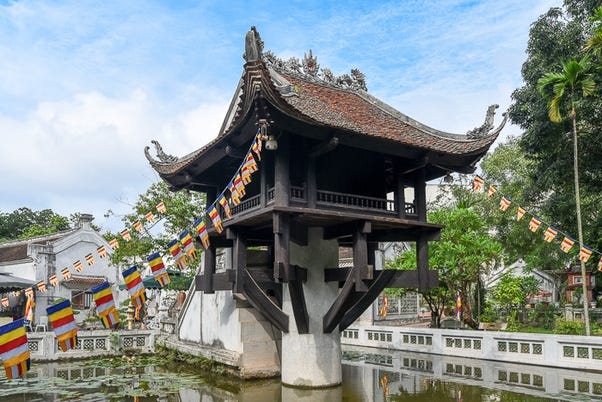Temple Architecture Styles : Việt architecture
Việt Architecture1 developed in the modern state of Việt Nam, primarily in its northern and central region (north of Campā) which comprised the core territory of Đại Cồ Việt and later Đại Việt.
It is heavily influenced by Zhōngguó architecture owing both to close contacts and to prolonged occupation of Việt Nam by Zhōngguó polities [comprises 4 period of Zhōngguó rule 111 BCE – 40 CE, 43 CE – 544 CE, 602 CE – 905/939 CE and 1407 CE – 1428 CE]. Limited degree of French influence may be seen due to French colonial occupation of Việt Nam (1887 CE – 1954 CE).
Development History
1st century CE – 11th century CE
Second Era of Zhōngguó Domination (Jiāozhǐ province / Jiāozhōu province) (43 CE – 544 CE)
Vạn Xuân (Early Lý dynasty) (544 CE – 602 CE)
Third Era of Zhōngguó Domination (602 CE – 905 CE or 938 CE)
Tĩnh Hải quân (Ngô dynasty) (939 CE – 965 CE)
Đại Cồ Việt
Đinh dynasty (968 CE – 980 CE)
Early Lê dynasty (980 CE – 1009 CE)
Polities:
For ~500 years, present-day northern Vietnam was ruled by Zhōngguó-based polities (termed Second Era of Zhōngguó Domination). By 2nd-3rd century CE, local sites and artifacts often contain both Yue and Han styles, include Han-style tomb bricks and Dong Son artifacts such as bronze drums. From the Han to the Tang era, Imperial Zhōngguó rulers had supported for the political alliances with the locally based Yue political elite, many of which were powerful and wealthy chieftains. The Zhōngguó court often gave them official positions to extract profits from them.
Second Era of Zhōngguó Domination also witnessed the rebellion and subsequent independence achieved by Línyì / Lâm Ấp which later became Campādēśa.
In 6th century CE, brothers Lý Bí and Lý Thiên Bảo revolted against the Zhōngguó Liang dynasty to gain independence, establishing Vạn Xuân (under Early Lý dynasty).
During Third Era of Zhōngguó Domination, Sui, Tang and Wu Zhou ruled over Việt Nam.
Religion and Temples:
During 2nd century CE, Indian merchants regularly visited Jiāozhǐ where the introduced Buddhism. Subsequently, Dâu Temple2, originally built in 2nd century CE, was established as the first Buddhist temple in Vietnam.
Trấn Quốc Pagoda was originally built under Early Lý dynasty
11th century CE – 13th century CE
Later Lý dynasty (1009 CE – 1225 CE)
Polities:
One of the major events of Lý dynasty was changing the name of the nation from Đại Cồ Việt (大瞿越) to Đại Việt (大越) in 1054 CE under the reign of Lý Thánh Tông.
Religion and Temples:
The main religion of the Lý dynasty was Buddhism. The first Lý emperor was a Buddhist monk, and was patronised by Buddhist leaders. Lý emperors were fundraisers and sponsors of the Buddhist saṅgha. Buddhism became the state religion as members of the imperial family and the nobility made pilgrimages, supported the building of pagodas, sometimes even entered monastic life, and otherwise took an active part in Buddhist practices. The kingdom was governed according to Buddhist ideas and laws. Emperors built pagodas to commemorate military victories, such as when Lý Thường Kiệt defeated Sòng dynasty, Bao An pagoda was built to show his gratitude for the Buddha. Bonzes (Buddhist monks) became a privileged landed class, exempt from taxes and military duty.
Along with Buddhism, the emperors also participated in other religious ceremonies involving local spirits, deities like Indra and Brahmā. Temples were built dedicated to 1st century CE military leaders Trưng sisters and 8th century CE military leader Phùng Hưng.
Domestically, while Lý emperors were devout in their adherence to Buddhism, the influence of Rújiào (Confucianism) from Zhōngguó was on the rise, with the opening of Văn Miếu (Temple of Literature) in 1070 CE, built for the veneration of Kǒng Fūzǐ and his disciples. In 1076 CE, Quốc Tử Giám (Guozijian) was established in the fifth courtyard of the same complex — initially the education was limited to the children of the emperor, the imperial family as well as mandarin and nobility, serving as Việt Nam’s first university institution.
Starting with Lý dynasty, Dǒugǒng/Đấu củng became rare to absent in Việt temples.
→ Fifth Courtyard, grounds of the imperial academy i.e. Guozijian in Văn Miếu Complex, Hanoi, Việt Nam [Source: File:Van Mieu Hanoi 16.jpg - Wikimedia Commons]
→ Old stone wall in Dạm pagoda complex (Built 11th century CE) [Source: File:Nền bó đá ở Chùa Dạm.JPG - Wikimedia Commons]
→ Typical roof decoration of Lý dynasty period [Source: Vietnamese Architecture - Reflecting One Part of Vietnamese Culture]
13th century CE – 15th century CE
Trần dynasty
Early Trần dynasty (1225 CE – 1400 CE)
Later Trần dynasty (1407 CE – 1413 CE)
Polities:
Trần dynasty was founded when emperor Trần Thái Tông ascended to the throne after his uncle Trần Thủ Độ orchestrated the overthrow of Lý dynasty. The Trần improved Zhōngguó gunpowder, enabling them to expand southward to defeat and vassalize Campā. They also successfully resisted two Mongγol invasions.
The final emperor of the dynasty was Thiếu Đế, who was forced to abdicate the throne in 1400 CE in favor of his maternal grandfather, Hồ Quý Ly. The Later Trần dynasty was a short lived restored polity that revolted against Zhōngguó Míng dynasty but was ultimately overthrown by them, continuing on the Fourth Zhōngguó Domination Period.
Religion and Temples:
As Buddhism was de facto the national religion of the Trần dynasty, there were many works of Trần literature that expressed the spirit of Buddhism and Zen, notably the works of the Emperor Trần Nhân Tông and other masters of Trúc Lâm School.
Despite so, Ruija education began to spread across the nation. The principal curricula during this time were Sìshū Wǔjīng (Four Books and Five Classics) and Zhōngguó history, which were at the beginning taught only at Buddhist pagodas and gradually brought to pupils in private classes organized by retired officials or Ruija scholars.
→ Trần dynasty commissioned pagodas examples — the pagodas have small straight eaves similar to early Zhōngguó pagodas:
Bình Sơn pagoda of Vĩnh Khánh Temple Complex in Vinh Phuc province, Vietnam.[Source:File:Binh Son tower 2.jpg - Wikimedia Commons]
Pagoda of Phổ Minh Temple Complex in Nam Định city, Nam Định Province, Vietnam [Source: File:Pho Minh tower.jpg - Wikimedia Commons]
→ [Screenshot from Trần dynasty - Wikipedia]
→ [Screenshots from Trần dynasty - Wikipedia]
15th century CE – 18th century CE
Later Lê dynasty
1428 CE – 1527 CE
1533 CE – 1789 CE [de facto Trịnh family rule]
Polities:
Lê dynasty officially began in 1428 CE with the enthronement of Lê Lợi after he drove Míng army from Việt Nam. It reached its peak during the reign of Lê Thánh Tông and declined after his death in 1497 CE.
Lê dynasty is divided into two historical periods:
Early period (1428–1527 CE) before usurpation by Mạc dynasty (1527–1683 CE), in which emperors ruled in their own right.
Restored period or Revival Lê (1533–1789 CE), in which honorary emperors reigned under the auspices of the powerful Trịnh family. Revival Lê period is marked by two lengthy civil wars: Lê–Mạc War (1533–1592 CE) in which two dynasties battled for legitimacy in northern Việt Nam and Trịnh–Nguyễn Wars (1627–1672 CE, 1774–1777 CE) between the Trịnh lords in North and the Nguyễn lords of the South. During the Revival Period, Nguyễn lords were de jure officials of the ruling Lê dynasty in Hanoi, but were de facto independent rulers of central & southern Việt Nam.
Religion and Temples:
The previously Buddhist state became Confucian after the preceding 20 years of Míng rule. Temples to Kǒng Fūzǐ were built throughout the provinces of Đại Việt.
→ View of a courtyard of Phuc Kien (Fukien) Assembly Hall in Hoi An, Vietnam — It is dedicated to Thien Hau or Mazu, the deity of the sea and the protector of sailors. Other deities worshipped here include the "Six Highly Esteemed Generals", a group of men who fought the newly-ascendent Qing in the waning years of the Míng dynasty, and Heavenly Midwives, to whom women pray for a successful pregnancy. (Built 1690 CE onwards) [Source: Phuc Kien Assembly Hall, Hoi An, Vietnam]
→ Trấn Quốc (National Defence) Pagoda was shifted to its present location on a small island near south-eastern shore of Hanoi's West Lake in 17th century CE under King Lê Kính Tông (1599-1619 CE). It was supposedly originally founded 1,400 years ago by King Lý Nam Đế (r. 503-548 CE) with the name Khai Quốc (National Founder) [Source: File:Chùa Trấn Quốc, Hà Nội.jpg - Wikimedia Commons]
→ Phước Duyên pagoda of Thiên Mụ Temple Complex in Huế, Thừa Thiên Huế province, Vietnam (Commissioned 1601 CE by Nguyễn Hoàng) [Source:File:Hue Vietnam Thien-Mu-Temple-and-Pagoda-01.jpg - Wikimedia Commons]
19th century CE – 1945 CE
Nguyễn dynasty
1802 CE – 1883 CE [sovereign rule]
1883 CE – 1945 CE [French Protectorate as part of Union Indochinoise]
Nguyễn dynasty was the last sovereign Việt dynasty. Nguyễn lords had already established themselves as de facto rulers of central & southern Việt Nam since 16th century CE, and ruled the unified Việt state independently from 1802 CE to 1883 CE before being under French protectorate.
Although the previous Nguyễn lords were faithful Buddhists, sovereign Nguyễn rule founder Nguyễn Phúc Ánh was not a Buddhist. He adopted Neo-Confucianism and actively restricted Buddhism. Scholars, elites, and officials attacked Buddhist doctrines and criticized them as superstitious and useless. The third emperor, Nguyễn Phúc Miên Tông, elevated Confucianism as the true religion and while regarding Buddhism as superstition. Building new Buddhist pagodas and temples were forbidden. Buddhist clergies and nuns were forced to join public works in order to limit the influence of Buddhism and promote Confucianism as the sole dominant belief of the society. In 1804 CE, Nguyễn Phúc Ánh built the Nam Hải Long Vương Temple (Temple of Southern Ocean Dragon King) in Thuận An, northeast of Hue in his faithfulness to the deity of Thuận An (Thần Thuận An), the place where most of cầu đảo (offering heaven for wind and rain during a drought) ritual was performed. His successor, Minh Mạng, continued to build several temples dedicated to the Vũ Sư (Rainmaking deity) and altars for Thần Mây (Cloud deity) and Thần Sấm (Thunder deity). However, Buddhism still maintained prevalence in mainstream society and had its presence within the imperial palace — empress mother, queens, princess, and concubines were devout Buddhists, despite the patriarchy prohibition.
After an imperial edict in late 1862 CE, Catholic Christianity was officially recognized and worshippers of the faith obtained state protection. Nguyễn Trường Tộ, a prominent Catholic and reformist intellectual, launched an attack on Confucian structures in 1867 CE as decadent.
→ Temple complexes commissioned during Nguyễn dynasty rule examples:
Dinh Bang Communal House in Bac Ninh Province, Vietnam (Built 1700–1736 CE) [Source: Dinh Bang Communal House, Bac Ninh Province, Vietnam]
Confucian Temple in Hoi An, Vietnam (Built 19th century CE or earlier) [Source: Confucian Temple, Hoi An, Vietnam]
Structural Details
Gateways
Gateways of Việt Architecture are usually Zhōngguó style triple-entrance gateways.
In most Việt Architecture temple complexes, various types of triple entrance gateways, termed Tam quan can be found.
Tam quan a.k.a. Tam môn
Tam quan a.k.a. Tam môn is a style of traditional gateway symbolic of Việt Buddhism having three aisles (traditionally, the middle aisle is the largest and the two side aisles are smaller).
They are applied not only in Buddhist works, but also commonly applied to other religious works such as Confucianism, Taoism, Việt folk religion, Đạo Mẫu, and Christianity. They are also applied to non-religious modern buildings such as schools and People's committee buildings.
Páifāng type Tam quan
→ Páifāng type Tam quan:
Gate to Linh Ung Pagoda in Son Tra Peninsula, Da Nang, Vietnam [Source: https://en.wikipedia.org/wiki/Tam_quan]
Tam quan of Thủy Long Thánh Mẫu Temple [Source: https://en.wikipedia.org/wiki/Tam_quan]
4-pillar type Tam quan
→ 4-pillar type Tam quan:
Tam quan of Thượng Temple [Source: https://en.wikipedia.org/wiki/Tam_quan]
Tam quan style of four pillars Quốc Ân Temple, Huế [Source: https://en.wikipedia.org/wiki/Tam_quan]
Multi-floor type Tam quan
Multi-floor type Tam quan usually have one storey built over the actual gate — the storey may be fake and serve the purpose of only increasing the gate’s height.
→ Multi-floor type Tam quan:
Tam quan of Thiên Mụ Temple with guardhouse built above the middle entrance, Huế royal style [Source: https://upload.wikimedia.org/wikipedia/commons/4/40/Chua_Thien_Mu_01.jpg]
Tam quan Dận Temple Complex [Source: https://en.wikipedia.org/wiki/Tam_quan]
Tam quan of Hương Temple Complex [Source: https://en.wikipedia.org/wiki/Tam_quan]
Ngũ Long Môn (Five Dragon Gate)
→ Ngũ Long Môn examples:
Ngũ Long Môn of Lý Bát Đế Temple Complex (formally Cổ Pháp Điện) in Hanoi, Vietnam [Source: https://commons.wikimedia.org/wiki/%C4%90%E1%BB%81n_L%C3%BD_B%C3%A1t_%C4%90%E1%BA%BF]
Interior construction
Wooden supports
Generally, wooden support beams are used to keep ceiling(s) in place.
→ Wooden supports examples:
Wooden supports of the ceiling of the pagoda of Thay Temple, Hanoi, Vietnam [Source: Thay Temple, Hanoi, Vietnam]
Brackets
While bracket are nearly absent in Việt architecture, some examples can still be found. Bracket and bracket ends are often highly decorated.
→ Brackets examples:
Brackets of bell of tower of Tram Gian Temple, Hanoi, Vietnam [Source: Tram Gian Temple, Hanoi, Vietnam]
→ Bracket ends examples:
Bracket end carved like 2 flowing dragons, in Dinh Bang Communal House, Bac Ninh Province, Vietnam [Source: Dinh Bang Communal House, Bac Ninh Province, Vietnam]
Bracket end carved like floating clouds, in Dinh Bang Communal House, Bac Ninh Province, Vietnam [Source: Dinh Bang Communal House, Bac Ninh Province, Vietnam]
Roofs
Similar to Zhōngguó architecture halls & pavilions, the roof eaves of Việt architecture structures are either of two extremes : completely straight or highly curved.
→ Highly curved eaves examples:
Highly curved eaves with dragon motifs at tips : Prayer hall of Dinh Bang Communal House, Bac Ninh Province, Vietnam [Source: Dinh Bang Communal House, Bac Ninh Province, Vietnam]
Highly curved eaves with dragon motifs at tips : Phat Tich Temple Complex, Bac Ninh Province, Vietnam [Source: Phat Tich Temple, Bac Ninh Province, Vietnam]
→ Straight eaves examples:
Worship hall of Phat Tich Temple Complex, Bac Ninh Province, Vietnam [Source: Phat Tich Temple, Bac Ninh Province, Vietnam]
Another hall of Phat Tich Temple Complex, Bac Ninh Province, Vietnam [Source: Phat Tich Temple, Bac Ninh Province, Vietnam]
Roof decorations
Dragon & Pearl Motif
Dragon & Pearl decoration consists of a pearl flanked by 2 dragons. It is commonly associated with buildings of Lý dynasty and those modelled on them.
→ Dragon & Pearl decoration on a roof of a pavilion in Ly Bat De Temple Complex, Bac Ninh Province, Vietnam [Source: Ly Bat De Temple, Bac Ninh Province, Vietnam]
Pagodas
Việt Pagodas are usually similar to Zhōngguó pagodas having their eaves as either of two extremes : completely straight or highly curved
When straight, the eaves are small, almost non-existent, and only demarcate between different storeys
When curved, the eaves protrude highly from the structure and visible more clearly.
→ Straight eaved pagodas: such pagodas are often built of stone and/or bricks
Hoa Phong pagoda (Built 1737 CE) of Phap Van Temple Complex in Bac Ninh Province, Vietnam [Source: Dau or Phap Van Temple]
→ Curved eaved pagoda example:
A small burial pagoda (Built 1664 CE) with small curving eaves, in Phat Tich Temple Complex, Bac Ninh Province, Vietnam [Source: Phat Tich Temple, Bac Ninh Province, Vietnam]
Halls & pavilions
→ Halls and pavilions examples:
Halls of Ly Bat De Temple Complex, Bac Ninh Province, Vietnam [Source: Screenshots from Ly Bat De Temple, Bac Ninh Province, Vietnam]
Halls of Phat Tich Temple Complex, Bac Ninh Province, Vietnam [Source: Phat Tich Temple, Bac Ninh Province, Vietnam]
Bell Towers
→ Bell Towers examples:
Bell Tower of Tram Gian Temple, Hanoi, Vietnam [Source: Screenshot from Tram Gian Temple, Hanoi, Vietnam]
Drum Towers
→ Drum Towers examples:
Drum Tower of Thay Temple Complex in Hanoi, Vietnam [Source: Thay Temple, Hanoi, Vietnam]
Temple Complexes
Axially symmetrical arrangement of buildings is generally followed in Việt temple complexes, but may not always be possible, especially when further additions are made to existing complexes.
→ Mostly axially symmetric arrangement of But Thap or Ninh Phuc Temple Complex in Bac Ninh Province, Vietnam — the abbot’s shrine and Bao Nghiem Padoga dont lie on the axis [Source: But Thap or Ninh Phuc Pagoda, Bac Ninh Province, Vietnam]
→ Phuc Kien Assembly Hall in Hoi An, Vietnam — the complex in entirety is asymmetric, but the middle portion (between A to H in below image) is axially symmetric [Source: Phuc Kien Assembly Hall, Hoi An, Vietnam]
Notable temples
One Pillar Pagoda
One Pillar Pagoda in Hanoi, Vietnam is a unique pagoda resting on a single pillar. It was originally constructed in 1049 CE, and destroyed several times over the course of centuries. The current structure dates to 1955 CE, and uses concrete for the pillar and stairs.
→ [Source: One Pillar Pagoda, Hanoi, Vietnam]
https://en.wikipedia.org/wiki/Vietnamese_architecture
https://en.wikipedia.org/wiki/D%C3%A2u_Temple





